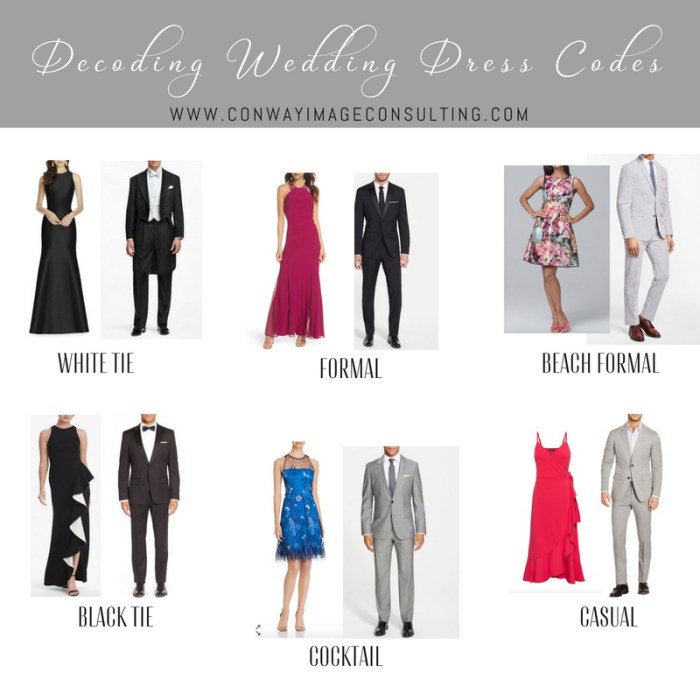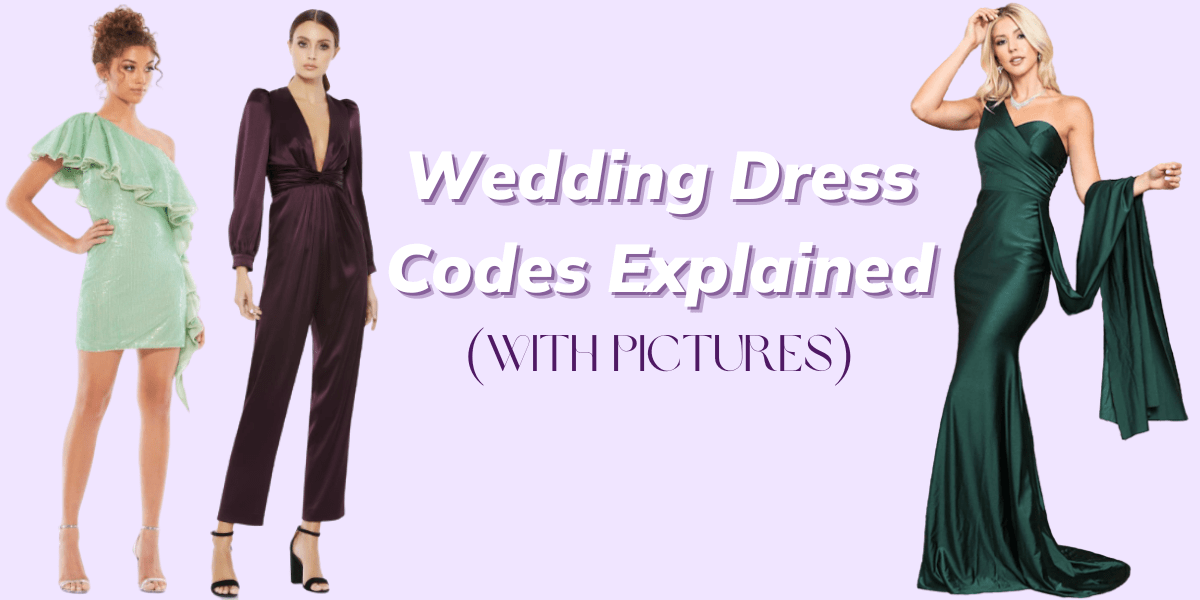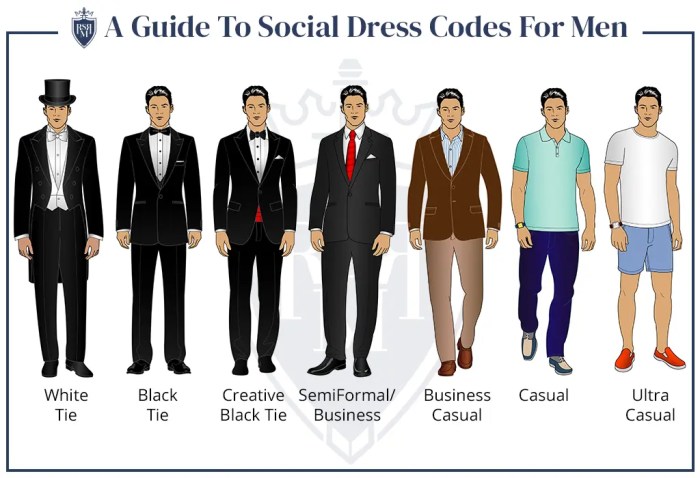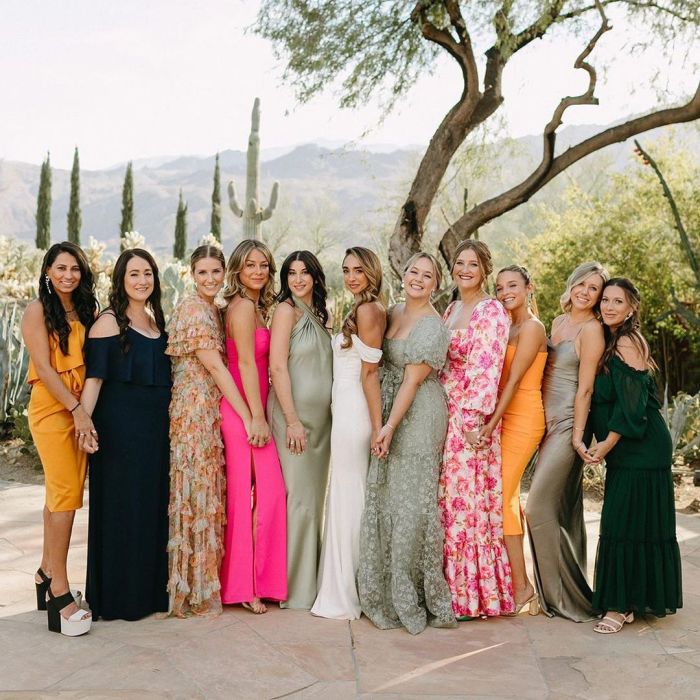Wedding Dress Codes Explained
Wedding dress codes explained – Navigating wedding dress codes can feel like deciphering a secret code, but understanding the nuances can ensure you feel confident and appropriately dressed for the celebration. This guide breaks down common dress codes, offering clarity and guidance for guests.
Introduction to Wedding Dress Codes
Wedding dress codes serve the crucial purpose of guiding guests on appropriate attire, contributing to the overall atmosphere and aesthetic of the wedding. They ensure a cohesive and visually pleasing event, reflecting the couple’s vision for their special day. Historically, dress code etiquette evolved from strict societal norms dictating formality based on social standing. Today, while less rigid, dress codes still provide a framework for guests to choose attire that respects the occasion.
Common wedding dress code terms include:
- Black-Tie: The most formal dress code, requiring elegant evening wear.
- Cocktail: A semi-formal dress code, allowing for stylish yet less formal attire.
- Semi-Formal: Similar to cocktail attire, but potentially slightly less dressy.
- Casual: A relaxed dress code, suitable for comfortable yet presentable clothing.
- Beach Formal: A blend of formal and casual, appropriate for beach settings.
Deciphering Common Dress Code Terms
Understanding the specifics of each dress code ensures you choose attire that aligns with the wedding’s formality.
Black-Tie Dress Code
Black-tie necessitates formal evening wear. Men typically wear tuxedos, while women opt for floor-length gowns.
| Attire Type | Description | Example | Image Description |
|---|---|---|---|
| Men’s Tuxedo | A formal suit with a tuxedo jacket, typically black or midnight blue, often paired with a bow tie and cummerbund. | Classic black tuxedo with a satin lapel, black bow tie, and patent leather shoes. | A sharply tailored black tuxedo with peak lapels, a crisp white shirt, a black bow tie, and black patent leather shoes. The overall look is sophisticated and elegant, reflecting the formality of the black-tie event. |
| Women’s Floor-Length Gown | An elegant, formal gown that typically reaches the floor. Fabrics such as silk, satin, or velvet are common. | A flowing, floor-length silk gown in a deep jewel tone, possibly featuring delicate beading or embroidery. | A luxurious floor-length gown in rich emerald green silk, featuring a fitted bodice and a flowing skirt. The gown is elegantly simple, with minimal embellishment, allowing the fabric and cut to speak for themselves. |
| Men’s Accessories | Cummerbund, bow tie, pocket square, cufflinks, patent leather shoes. | A black silk cummerbund, a matching bow tie, a crisp white pocket square, and elegant cufflinks. | The accessories are carefully chosen to complement the tuxedo, creating a cohesive and polished look. The pocket square adds a touch of personality without being overly flashy. |
| Women’s Accessories | Elegant jewelry (avoiding anything overly flashy), a clutch, heels. | Delicate diamond earrings, a simple pearl necklace, and a small, elegant clutch. | The accessories are understated yet sophisticated, complementing the gown without detracting from its elegance. The jewelry is simple but refined, adding a touch of sparkle without being overwhelming. |
Cocktail Attire vs. Semi-Formal Attire
While often used interchangeably, cocktail attire tends to be slightly more dressy than semi-formal.
Cocktail Attire:
- Women: Cocktail dresses (knee-length or slightly below), dressy jumpsuits, skirts and tops.
- Men: Suits (dark colors preferred), dress pants and a button-down shirt (with or without a tie).
Semi-Formal Attire:
- Women: Knee-length or midi dresses, skirts and blouses, dressy pantsuits.
- Men: Suits (less strict color requirements), dress pants and a collared shirt (tie optional).
Casual and Beach Formal Dress Codes
Casual and Beach Formal represent the more relaxed end of the spectrum.
Casual: Acceptable attire includes sundresses, khakis, and button-down shirts. Unacceptable attire would be jeans and t-shirts (unless explicitly stated otherwise), athletic wear, or anything overly revealing.
Beach Formal: This allows for a more relaxed approach to formality. Flowing maxi dresses, linen pants, and guayaberas are suitable. Avoid overly casual attire like flip-flops and swimwear.
Understanding the Wedding Venue’s Influence

Source: conwayimageconsulting.com
The wedding venue significantly impacts the appropriate dress code. A church wedding often calls for more formal attire than a beach wedding.
Venue Influence Flowchart:
Start → Venue (Church, Beach, Ballroom, Rustic Barn, etc.) → Dress Code (Black-Tie, Cocktail, Semi-Formal, Casual, Beach Formal, etc.) → Attire Selection
Rustic vs. Formal Wedding Attire: A rustic wedding might suggest more relaxed attire like flowy dresses and linen suits, whereas a formal wedding in a ballroom typically calls for floor-length gowns and tuxedos.
Addressing Special Considerations
Guests with disabilities, religious restrictions, or those traveling from different climates should be accommodated. Plus-size guests should find appropriate and stylish options that match the dress code, just as any other guest would.
Appropriate attire should always prioritize comfort and respect cultural sensitivities.
Guest Etiquette and Dress Code Adherence, Wedding dress codes explained

Source: queenly.com
If the dress code is unclear, respectfully inquire with the wedding party or a close friend of the couple. Common dress code mistakes include wearing white (unless explicitly permitted), overly casual attire at formal weddings, and attire that is too revealing.
Accessories should complement the outfit and the overall dress code without overshadowing the bride.
Illustrative Examples of Wedding Attire

Source: realmenrealstyle.com
Understanding wedding dress codes can be tricky, ranging from black-tie formal to casual beach affairs. The level of formality often dictates the guest’s attire, much like choosing the right ambiance for your home; for instance, the lighting and decor you select, perhaps even incorporating elements like those found at deko wohnzimmer lichterkette pflanze , can greatly impact the overall feel of a space.
Returning to wedding attire, remember to always check the invitation for specific guidelines to ensure you’re appropriately dressed for the celebration.
The following are examples of suitable attire for various wedding scenarios.
Black-Tie Wedding Attire
Men: A classic black tuxedo with a satin lapel, crisp white shirt, black bow tie, black patent leather shoes, and a simple pocket square. The fabric should be high-quality wool or silk.
Women: A floor-length gown in a rich jewel tone (emerald, sapphire, ruby) made of silk or velvet. The gown could feature subtle embellishments like beading or embroidery. Accessories should be elegant and understated.
Casual Outdoor Wedding Attire
Men: Linen pants or khakis, a crisp button-down shirt (possibly in a light color), loafers or boat shoes. The fabric should be breathable and comfortable.
Women: A flowy midi dress in a floral print or a solid pastel color made of cotton or linen. Comfortable sandals or wedges would be appropriate.
Cocktail Wedding Reception Attire
Men: A dark-colored suit, a crisp button-down shirt, and a tie (optional). Leather dress shoes would complete the look.
Women: A knee-length cocktail dress in a flattering silhouette. The fabric could be silk, lace, or a similar dressy material. Accessories could include statement jewelry, a clutch, and heels.
FAQ: Wedding Dress Codes Explained
What if the invitation doesn’t specify a dress code?
If unsure, it’s always best to politely inquire with the wedding party or a close friend of the couple. A safe bet is typically semi-formal attire.
Can I wear white to a wedding?
Generally, it’s best to avoid wearing white to a wedding, as it’s traditionally reserved for the bride. Other very light pastel colors are usually acceptable.
What about wearing black to a wedding?
Black is generally acceptable unless the wedding is very informal. Consider pairing it with colorful accessories to avoid appearing too somber.
Is it okay to wear jeans to a wedding?
Jeans are only appropriate for very casual weddings, such as a beach wedding specifically indicating casual attire. Even then, choose a well-fitting, dark-wash pair and dress it up with a nice top.

